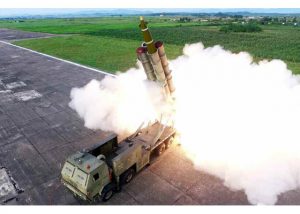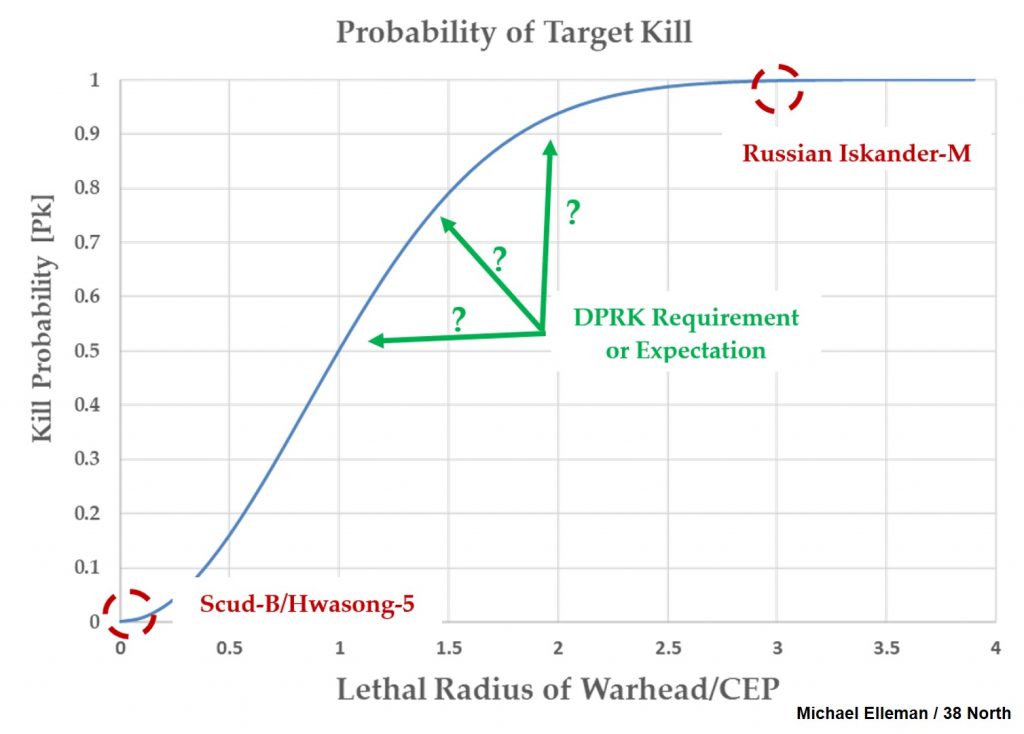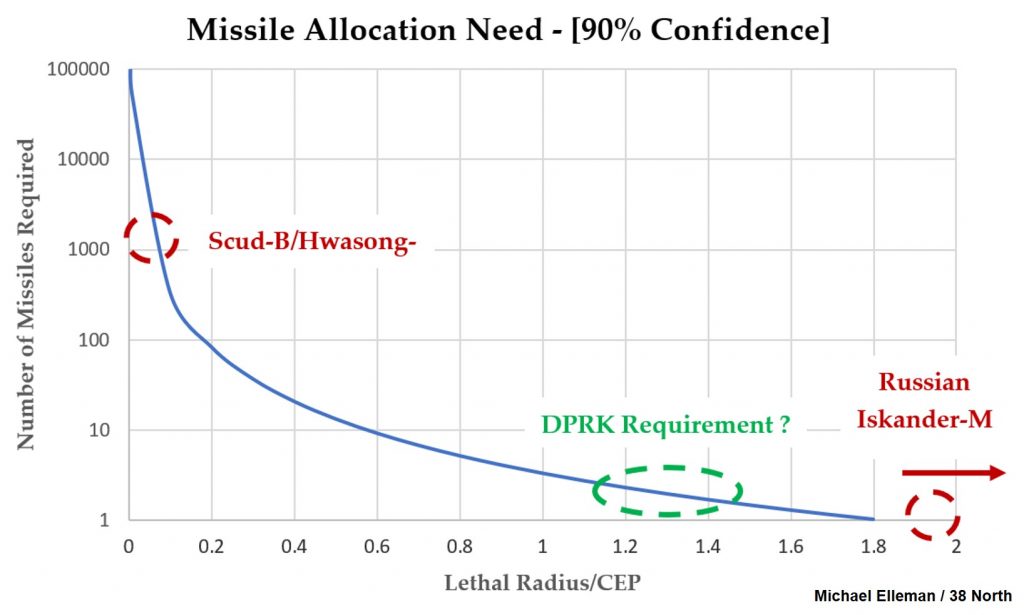North Korea’s New Short-Range Missiles: A Technical Evaluation
Since May, North Korea has flight tested three new, solid-fuel, short-range ballistic missiles (SRBM). In addition, the North test fired the 300-mm diameter KN-09 projectile, which was initially unveiled six years ago. (The tests have been documented and preliminarily assessed by 38 North.) The new SRBMs appear to be designed for the precision delivery of conventional warheads, though one or two of them may be dual-capable.
This article seeks to explain the advances in missile accuracy North Korea must make to create an SRBM arsenal that has substantial military value when armed with conventional warheads. It reaches the following principal conclusions:
- Full development of the KN-23, KN-24 and KN-25 missiles will each require additional flight tests, and the number of tests will likely reflect North Korea’s larger objectives;
- Extensive flight testing would suggest North Korea seeks to establish a potent conventional-warfighting capability with its short-range missile forces;
- Deployment of these new missiles without further testing would limit improvements in missile accuracy and suggest more limited military aims. Limited missile accuracy demands a greater number of missiles fired at each target for similar target destruction probabilities; and
- Regardless of future decisions on flight testing, North Korea is likely to replace its stockpile of Hwasong-5 and Hwasong-6 missiles with some combination of the systems currently under development because the solid-fuel missiles offer greater operational flexibility and pre-launch survivability.
The Legacy Systems
Prior to this year, North Korea relied on several types of short-range missiles to meet its strategic need to hold targets on the peninsula at risk. The Hwasong-5 and -6 missiles (based on the Soviet-made Scud-B and -C) can strike targets at a range of 300 and 500 km, respectively, and have been fielded by North Korean forces since the late-1980s. These liquid-fuel missiles are notoriously inaccurate, a shortcoming that limits their military utility unless armed with nuclear warheads. Beginning in 2015, North Korea initiated a couple of test launches aimed at improving the accuracy of the Hwasong-5 and -6 missiles by equipping them with maneuverable warheads. Only three flight tests have been completed, with one ending in failure, suggesting little progress has been made to date. US intelligence refers to those upgraded missiles as the KN-21 and KN-18, respectively. The KN-21 has a range of approximately 250 km, while the KN-18 can reach targets at about 450 km.
North Korea also introduced, and test launched at least 20 times, the solid-fuel KN-02 Toksa. The KN-02 appears to be modeled after the Soviet-designed and -manufactured Tochka (SS-21) missile, which has a range of up to 120 km and is highly accurate. The accuracy achieved by North Korea’s KN-02 during testing is not publicly known, though it is reasonable to assume that Pyongyang was satisfied with the results after 20 flight tests. The apparent success in developing Toksa may have convinced the regime to extrapolate the results by applying similar technologies and techniques to missiles that can reach targets deeper inside South Korea.
The New Missiles

The solid-fuel missiles North Korea began testing in May of this year replicate many of the range-payload capabilities offered by the five legacy systems described above, although each new system appears to be designed for precision delivery of conventional warheads, much like the KN-02. The KN-23, whose external features closely resemble the Russian Iskander missile (9M723, SS-26), can reach distances of 420 and 450 km, and possibly more than 600 km. The KN-24 appears to be modeled after the US Army Tactical Missile System (ATACMS), and has been tested to a range of up to 400 km, while the KN-25 guided, “super-large” diameter (~450 mm) multiple-launch rocket system has reached distances of 380 km.[1] Finally, the KN-09, which was initially tested a few years ago and several times this year, is a 300-mm guided, multiple-launch rocket system with a range of about 250 km.
All four missile variants employ flattened trajectories to ensure that they remain below an altitude of about 50 km, where the atmosphere is dense enough to effect course corrections using aerodynamic surfaces over the missile’s entire flight path. In principle, the new North Korean missiles should be capable of active steering throughout flight and diving toward a designated target to achieve highly accurate delivery of warheads. Circular error probable (CEP) values of about 100 meters are possible if the missiles are aided by satellite navigation; in the absence of this assistance, missiles must rely on inertial-navigation systems, which would limit CEP to roughly 100 to 200 meters. (CEP is defined as the radius of a circle within which one-half of the missiles launched will land if aimed at the circle’s center.)[2]
The Importance of Accuracy
The military or strategic utility of a ballistic missile is determined by three factors: 1) the accuracy with which the warhead can be delivered on a consistent basis; 2) the lethal effects of the warhead it delivers; and 3) the vulnerability of the target. Missile accuracy is typically expressed in terms of CEP. The lethality of a high-explosive warhead of a given mass is governed by the target’s vulnerability to the shockwave and accompanying shrapnel. For a target with specified vulnerabilities, a lethal radius inside which a target is killed, incapacitated or destroyed, can be defined for a given explosive mass. A warhead’s lethal radius increases as the vulnerability of the target grows, with the most fragile objects being destroyed at the greatest distance from the point at which the warhead detonates. Destruction of a hardened facility, for instance, requires a 500-kg warhead to detonate within roughly 20 meters of its target; to incapacitate an exposed airplane on the ground, the same warhead mass must strike within about 60 meters.[3] If the warhead mass increases to 1,000 kg, the lethal radius for the same target types grows to 25 meters and 70 meters, respectively. To double the lethal radius of a warhead composed of a single explosive charge, known as a unitary warhead, one most increase the explosive mass by a factor of eight.[4]
Despite the many flight tests conducted this year by North Korea, little is publicly known about the accuracy of the new missiles. There is no publicly available information about the size and type of warheads carried by North Korea’s newest missiles, although they likely range between 250 and 500 kg. One can, however, project potential military effectiveness of the new missiles by plotting the probability of target destruction as a function of the warhead’s lethal radius divided by the expected CEP value for missile accuracy, as shown in Figure 1.
Figure 1. Probability of target kill.

The KN-23 and KN-24 missiles are likely armed with either a unitary warhead containing roughly 400 to 500 kg of high-explosives, or a submunition warhead packed with a few hundred smaller charges. For most target types, the lethal radius of such warheads will range between 50 and 100 meters, with the larger distance associated with a submunition warhead against soft targets. The curve depicted in Figure 1, shows that to have a reasonable chance (e.g. 50 to 75%) of detroying a target, CEP values of between 50 and 100 meters are necessary for a 50% success rate and between about 35 and 70 meters for success 75% of the time. The KN-09 and KN-25 likely carry somewhat smaller warheads, perhaps half the size of the KN-23 or KN-24. The lethal radius of these smaller warheads will be marginally less, because halving the warhead mass reduces the lethal radius by only 20%. If a 90% chance of each missile destroying a target is expected, the CEP requirement drops to below 25 meters. Such precision demands, at the very least, satellite-navigation assistance, and a terminal homing device (either optical or radar correlation systems) mounted in the top of the missile’s nosecone.
Military planners responsible for incapacitating or destroying specific targets usually translate the calculated probabilities of success into the number of missiles required for the mission. This requirement provides additional insight into what North Korea might hope to achieve with its newest short-range missiles. Figure 2 plots the calculated number of missiles needed to destroy a target as a function of lethal radius divided by the CEP for an expected success probability of 0.9.[5] The curve shows that if the CEP value is twice that of the lethal radius (e.g. for a lethal radius/CEP of 0.5), up to 13 missiles must be assigned and launched at the target to expect success 90% of the time. In other words, if the lethal radius of the warhead is 50 meters, and the CEP is about 100 meters, a commander expecting a 90% level of confidence for target destruction must fire at least 13 missiles. While this may seem like a large number of missiles to take out a single target with a high degree of confidence, consider the challenge facing North Korean war planners when only the Hwasong-5 was available for use. In that case, more than 1,000 Hwasong-5s would be required, for a single target. This places the need for missile accuracy in sharp relief.
Figure 2. Missile allocation need.

It is difficult to know what North Korea hopes to achieve with its arsenal of short-range missiles. However, if we assume planners seek great confidence (i.e. 90%) in an ability to destroy key targets by assigning just two missiles to each target, we can project the CEP requirements for the new KN-23, -24 and -25 systems, highlighted in the green oval in Figure 2. This translates to CEP values considerably less than the lethal radius of the warhead, or roughly less than 40 meters. This capability would likely require each missile to be fitted with either an optical- or radar-correlation seeker to augment its satellite-navigation system. Further, it would necessitate extensive flight testing against a variety of target types to master the entire system.
Perhaps North Korea has less ambitious aims and will settle for CEP values on the order of 100 to 200 meters, in which case, up to ten missiles must be dedicated to each critical target to have high confidence in success. Such an aim is plausible if North Korea continues developing the KN-23, -24, and -25 missiles through a rigorous flight-test program. With the addition of satellite-navigation recievers to update and correct errors induced by the inertial navigation unit, CEP values of 100 meters or below might be achievable.
Conclusion
Based on North Korea’s experience developing the KN-02 missile, which underwent at least 20 flight tests, it seems likely that each new missile system currently being developed will require a similar number of test launches. However, one cannot dismiss the possibility that leaders in Pyongyang are already satisfied with the test results achieved to date, as it is highly probable that the current KN-23, -24, and -25 missiles are more accurate that their Scud-based counterparts. In this case, the last remaining hurdle would be missile reliability and the proven knowledge that they perform as designed under a variety of operational conditions.
- [1]
North Korea tested very-large diameter missiles on July 31 and August 2, 2019, which Pyongyang described as a “newly-developed large-caliber multiple launch guided rocket system”. The tests are summarized by 38 North, but the dimensions of the missiles test-fired remains a mystery. It is unclear if the new system was simply an extended-range version of the KN-09, a larger-diameter (say 400 mm) missile and test bed for the “super-large diameter” KN-25, or the KN-25 itself.
- [2]
CEP is a statistical measure of accuracy derived from the results of many flight tests. There is insufficient information in the public domain to determine if North Korea’s new missiles can realize CEP values of less than 100 meters.
- [3]
Michael Elleman, Iran’s Ballistic Missile Capabilities: a net assessment, (London: IISS, 2010) pp. 121-129.
- [4]
Alternatively, a warhead’s lethal radius can be more effectively expanded by subdividing it into a package of smaller charges that can be distributed over a larger area directly above or very near the target. America’s ATACMS, for example, can be armed with a 560-kg warhead containing 950 M74 bomblets, or an equivalently sized unitary warhead. The lethal radius for the submunition warhead is just over twice that of the unitary one. While submunitions increase the lethal radius of a missile warhead, they sacrifice the capacity to destroy hardened targets because the smaller bomblets lack explosive power. Shaped charges can be used to penetrate armored personnel carriers and tanks, but they cannot sufficiently damage reinforced concrete structures. Consequently, submunition warheads are designed to destroy or incapacitate soft targets, such as exposed radars, military vehicles, aircraft, and personnel. For more details, see Elleman, Iran’s Ballistic Missile Capabilities: a net assessment.
- [5]
In other words, to achieve mission success 90% of the time (on a statistical basis), the number of missiles that must be allocated or launched toward the target can be determined
